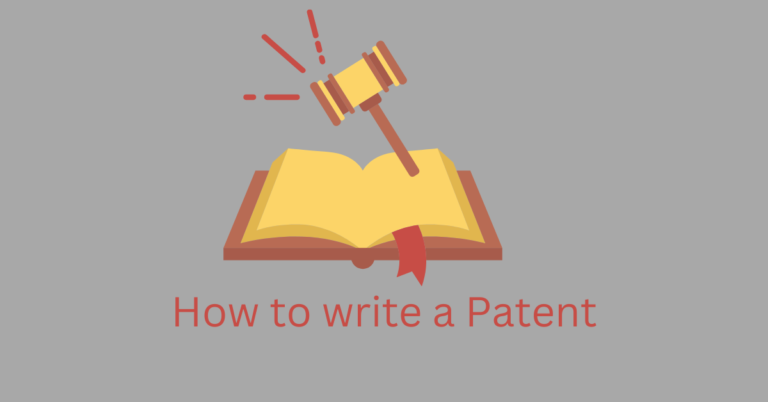A patent is an exclusive right granted to an invention. To obtain a Patent it is very important to write a Patent application clearly by explaining the details of performing the invention. Patent Application is a techno-legal document, so one has to follow the guidelines provided in the Indian Patent act, 1970 and Patent rules, 2003 to write the Patent Application. The drafting of Patent Application plays a vital role in the prosecution process and also after the grant of the Patent this document plays important role in disclosing the invention.
Table of Contents
ToggleContents of Patent Application
The Indian Patent act, 1970 under section 10 states that Patent specification should fully and particularly describe the invention and manner in which it has to be performed. The specification or disclosure is the written description of an invention, containing full scientific details of the invention and claims related to the Patent rights. It is very important in the Patent Application to follow the guidelines provided in the Patent law. Patent Application can be filed as provisional specification or as a complete specification.
A provisional specification is filed by the inventor when the invention has attained a stage where the invention can be disclosed in the paper, but it is not reached the final stage. The benefit of filing a provisional application provides a priority date to the invention. There is no need of filing patent claims at the time of filing a provisional specification.
According to section 10 of Indian Patent act, 1970, the content of Patent application (complete specification) should include:
- Title of the invention.
- Field of the invention
- Background of the invention.
- Object of the invention.
- Summary of the invention.
- Detailed description of the invention.
- Drawings.
- Best method.
- Claims.
- Abstract.
Title
The title of the invention should be very clear and specifically should disclose the subject matter to which the invention relates. The title should be free from any fancy words and the title should not exceed more than 15 words.
Filed of the invention
Filed of the invention should explain the technology to which the invention belongs and it can also explain the purpose and advantage of performing the invention.
Background of the invention
The background of the invention should clearly describe the problem associated in the existing technology, the challenges faced, what are the existing solution, and how to overcome the challenges by using the new invented invention. The most relevant prior art can be explained here to clearly bring out the difference between the novel and inventive concept associated with the existing technology and the invention.
Object of the invention
The object of the invention should explain the problems in existing technology and advantages of performing the invention.
Summary of the invention
In this section the summary of the invention describes the different technical features of the invention.
Detail description of the invention
This section of the Patent specification is very important to clearly explain each and every detail of performing the invention. By writing the clear and crisp detail description, one can easily defend the Patent application during prosecution and the maximum number of objections can be avoided.
Drawings
To explain the clear picture of the invention drawings are very important. The visuals of performing the invention or different parts of the invention can be easily described in the drawings. The drawings also help in easily explaining each and every detail of the invention in the detail description.
Best method
It is always very crucial to describe the best and easy method of performing the invention. This will lead to defend your invention during prosecution process. The process of explaining inventive concept of the invention can be made possible using the best method available efficiently.
Claims
Claims are very important part of the Patent Application as they describe the technical aspects covered by the invention and features to which protection is requested. For writing the claims, a special skill is required because the probability of getting grant of a Patent depends on the writing the proper clear claims in the broadest way possible to seek protection.
There are different types of claims to explain different scope of invention, they are:
Independent claim
Independent claims are the broadest claims. They are stand alone claims and do not require references from any other claims. The independent claim or principal claim should cover all the essential novel features required for performing the invention.
Dependent claim
Dependent claims are always depending on an independent claim or another dependent claim. The features of the dependent claims are always narrower than the claim on which they depend.
Parts of the claim
A Patent claim constitutes three parts:
Preamble
The preamble of the invention identifies the category and purpose of the invention. That is preamble explains whether the invention is related to a device or an apparatus or a method/process or a composition.
Transitional phrase
It is used to link the preamble of the invention to a different element of the claim. The transitional phrase is of two types.
a. Open-ended transitional phrase: It gives the claim an interpretation of including the stated elements of the invention but not excluding the other elements of the invention.
Example: “Comprising”, “including”, “containing”. Etc.
b. Close-ended phrase: It gives an interpretation of being limited to nothing more than the specifically-recited elements in the claims.
Example: “consisting of”, “consisting essentially of”.
c. The body of the claims:
It explains the invention’s elements and their relationship with each other.
Types of claims based on subject matter:
Process claim
A process claim is used for the process inventions and has to clearly define the steps involved in the process.
Product claim
A product claim may be claimed as an apparatus or a device or a system or any other product.
Composition claim
A composition claim is directed to a composition of matter. For example, a newly synthesized chemical compound or molecule may be claimed as a composition of matter.
Abstract
Abstract is a brief summary of the invention. The abstract is similar to broadest claim. It describes the technical features of the invention. The abstract should begin with title of the invention and total number of words should not exceed 150 words.
How to write a Design Patent
A design patent protects the design or unique appearance of a manufactured object. A design patent is available to those who invent a new and non-obvious ornamental design for an object. A design patent application contains the below elements:
Abstract or preamble
This section explains the general introduction of the design to be protected.
Title
This is the name given for the new design from the creator.
Description
This section explains the different attributes of the design.
Claim
Unlike utility patent claim, the design patent claim has a single claim. The single claim should describe the specific aspect of the design that is novel and unique.
Figures or drawings
It should include at least seven drawings or photographs of the design to be claimed. The drawings or photographs should show all sides of the object design. One of the drawings/photographs should be a three-dimensional image.
Example to explain the structure of a Patent Application:
The Patent act 1970
(39 of 1970)
The Patent rules, 2003
Complete Specification
(See section 10 and Rule 13)
Title:
Aqueous solution for cleaning contact lens
Field of invention:
The present invention relates to an aqueous solution for cleaning contact lenses constituting water soluble peroxide, transition metal salts and a surfactant.
Background of the invention:
Lenses must be sterilized to prevent transmission of pathogenic agents onto the eye. Some lens polymers, like hydrogels, cannot be chemically sterilized because they absorb antimicrobial grugs which can cause irritation in eye, so alternative sterilization technique like heat in the form of boiling water or steam are used.
Therefore, it is required to find a simple and efficient method for cleaning contact lenses which will ensure the removal of all soils.
Summary of the invention:
It is an objective of the present invention is to provide a simple, practical, and efficient method for the preparation of an aqueous solution for cleaning contact lens.
Detailed description of the invention:
In general representation of the present invention, an efficient method for the preparation of aqueous solution for cleaning plastic contact lens materials. The solution is a mixture of : a)water-soluble peroxides; b) a water soluble transition metal catalyst in the form organic or inorganic salt; and c) a coco hydrolyzed animal protein anionic surfactant.
Claims:
We claim:
An aqueous solution for cleaning contact lens which is comprising of:
(i) . a water-soluble peroxide;
(ii). a catalytic amount of a water soluble transition metal catalyst in the form of an organic or inorganic salt;
(iii). a coco-hydrolyzed animal protein anionic surfactant.
Abstract:
The present invention is related to an aqueous solution for cleaning plastic contact lens material wherein the aqueous solution is composed of water-soluble peroxides, a water-soluble transition metal catalyst in the form of organic or inorganic salt and a surfactant.






